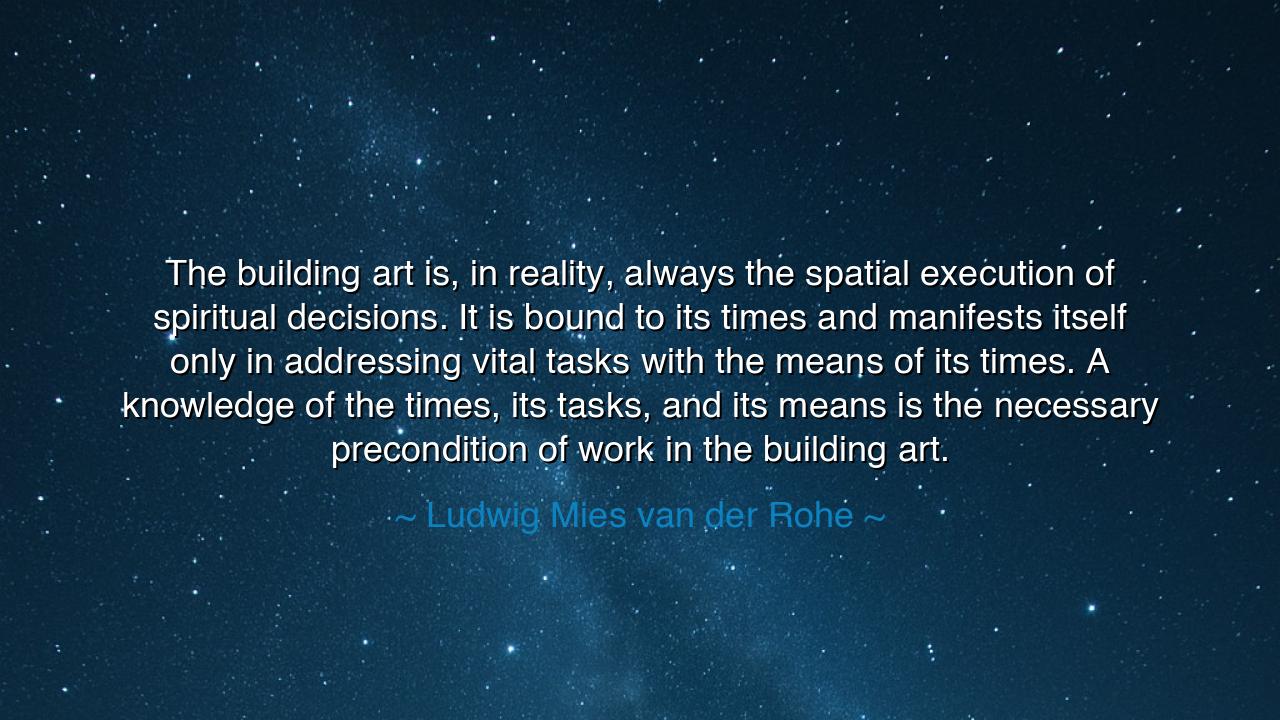
The building art is, in reality, always the spatial execution of
The building art is, in reality, always the spatial execution of spiritual decisions. It is bound to its times and manifests itself only in addressing vital tasks with the means of its times. A knowledge of the times, its tasks, and its means is the necessary precondition of work in the building art.






The words of Ludwig Mies van der Rohe flow with the gravity of a master craftsman who has gazed beyond stone and steel into the soul of creation: “The building art is, in reality, always the spatial execution of spiritual decisions. It is bound to its times and manifests itself only in addressing vital tasks with the means of its times. A knowledge of the times, its tasks, and its means is the necessary precondition of work in the building art.” Here, he does not speak of walls and roofs alone, but of the living heartbeat of architecture, which is nothing less than the spirit of an age made visible.
In declaring that building is the execution of spiritual decisions, Mies reveals that every structure—whether humble home or soaring cathedral—is a mirror of the values, beliefs, and aspirations of the people who raised it. A society that loves grandeur will build monuments of stone that tower to the skies; a society that loves simplicity will build with clarity and restraint. Architecture is never just utility—it is spirit, frozen in form, carried into eternity through space.
He reminds us also that building is bound to its times. No builder works outside of history. The pyramids of Egypt could not have risen without the laboring masses of that era and the divine kingship they worshiped. The Gothic cathedrals of Europe, with their flying buttresses and stained glass, were born of the medieval soul yearning for heaven. And Mies himself, living in the modern age, gave us buildings of glass and steel that reflected the precision, clarity, and efficiency of the twentieth century. Each was not only art, but the task of its age, made manifest through the means at hand.
Consider the story of the Parthenon in Athens. This temple was not built merely to house a statue of Athena. It was the material embodiment of a people’s devotion to order, proportion, and harmony—their belief that man, through reason, could mirror the beauty of the cosmos. Its marble columns were more than stone; they were the physical expression of a spiritual decision to honor wisdom and beauty as the highest pursuits of man. The Parthenon teaches us that every age leaves its soul carved into the forms it raises.
Yet Mies is careful to add that knowledge of the times, tasks, and means is the precondition of true building. To build blindly, without understanding the spirit of one’s age, is to raise hollow shells. The wise architect does not imitate the past but listens deeply to the needs of the present: the hunger for light, for space, for clarity, for unity. Only then can he transform wood, glass, or stone into something more than shelter—into a dwelling for the human spirit. Thus, the architect must be both craftsman and philosopher, both builder and interpreter of the times.
This wisdom speaks beyond architecture. For in truth, all our works—be they buildings, books, or policies—are the spatial execution of spiritual decisions. What we value inwardly shapes what we create outwardly. If we cherish greed, we build towers of arrogance. If we cherish justice, we build halls of fairness. If we cherish beauty, we raise gardens where the soul can breathe. Every creation is bound to its age, and the mark of greatness is whether it answers the deep needs of its people with the tools its time provides.
The lesson for us is profound: do not build—whether in stone, in words, or in deeds—without first asking, What is the spirit of my time? What are the tasks that cry out to be answered? What means lie within my hand? Seek alignment between these three, and your work will endure, not as imitation, but as a true expression of your age. In this way, you, too, will participate in the eternal dialogue of humanity with itself, leaving behind forms that speak of the soul of your time.
Therefore, O listener, heed the wisdom of Mies van der Rohe: architecture is spirit made space. Let your works, whatever their form, be born of decisions rooted in the soul, shaped by the needs of the present, and crafted with the tools of your moment. For only then will they rise, not as lifeless shells, but as living testaments to the greatness of your age, whispering to generations yet unborn of who you were, and what you cherished.






AAdministratorAdministrator
Welcome, honored guests. Please leave a comment, we will respond soon